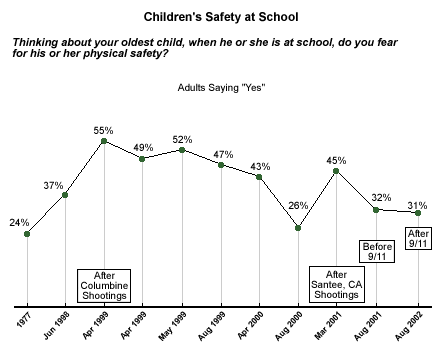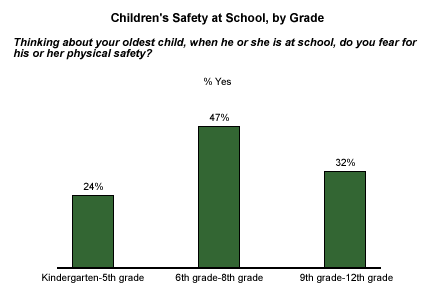On the morning of Sept.11, 2001, after learning of the terrorist attacks in Washington, D.C., and New York, Janet Gauss of New Smyrna Beach, Fla., did something that countless parents all over the country also did -- she called her son's school to "make sure he was safe."
It's natural for parents to want to ensure the safety of their children when disaster strikes. But according to a recent Gallup Poll*, nearly one-third of all parents say they fear for the safety of their child when he or she is at school. In fact, the percentage of parents saying they fear for their oldest child's physical safety at school has remained similar to what it was in an August 2001 poll (32% in August 2001 and 31% in August 2002). However, the level of concern has varied over time and tends to spike whenever an incident of school violence attains widespread media coverage. For example, in March 2001 shortly after a deadly school shooting in Santee, Calif., a Gallup Poll found 45% of parents expressing fear for the safety of their child after being at just 26% a few months prior.

Women Worry More Than Men
Aggregated data from Gallup's 2000-2002 annual polls** on Work and Education shed some light on which parents tend to worry about school safety more than others. Women are slightly more likely than are men to express worry, by a 34% to 26% margin. This may be part of a general pattern seen in polling, in which women are more likely to express feelings of fear or insecurity. When questioned whether they, themselves, are concerned about being the victim of a terrorist attack***, 47% of women say they were very or somewhat worried compared to 28% of men. It's difficult to know if this pattern reflects true differences in emotional reactions, or differences in willingness to admit to emotions that men may perceive as "weak."
Public School, Middle School Parents More Worried
Parents of children in public school are nearly twice as likely to say they worry as those with children in non-public schools -- 32% versus 18%. Perhaps non-public school parents have different perceptions of safety because the student-to-teacher ratio is generally smaller in non-public schools and supervision may be more manageable.
Concern about school safety, however, takes a big leap among all parents when children move from elementary school to middle school and high school.Just 24% of parents whose oldest child is in elementary school express concern for their child's safety at school, but 47% of parents whose oldest child is in middle school or high school do."Of course I worry much more now that he's in middle school," says Gauss, whose son just started sixth grade in a public school. "When he was in elementary school, I fretted about his being hurt on the playground during roughhousing. But now I worry about very different things -- his being bullied, beaten up -- or worse, possibly being molested by older kids or staff members."

Race, Income, Education and Location
Whites tend to be somewhat less concerned with school safety than do nonwhites -- 27% versus 40%, respectively, as are those whose annual incomes are $75,000 or more (19%) compared to those with incomes of $20,000 or less (47%). Parents with at least some college education are less likely to worry than parents with a high school education or less, 23% compared to 42%. It has been well documented that higher education leads to higher-paying jobs, which ultimately may place more educated parents in safer neighborhoods where they aren't as concerned about the safety of their children in school.
Surprisingly, suburban (31%) and rural (26%) parents are about as likely to worry about their children as parents in cities (31%). Suburban parents may be more jittery about crime than urban parents are, who, owing to the higher crime rate in most cities, must find a way to emotionally deal with the risk of crime on a daily basis. The towns of Jonesboro, Ark., West Paducah, Ky., and Littleton, Colo., -- all areas with low crime -- have been sites of some of the worst incidents of school violence in America.
Betsy Thompson, coordinator of the Safe and Drug-Free Schools program for Jefferson County Schools in Colorado -- including Columbine High School, site of the horrendous April 1999 shootings -- has studied the issues surrounding school safety perhaps more than anyone. "All parents really want their children to be safe and to thrive at school," says Thompson. "If kids are doing well at school, my sense is that parents are feeling that the safety factor has kicked in." Thompson makes a valuable point. Only 24% of parents who are satisfied with their child's education fear for his or her safety at school, while close to half (47%) of dissatisfied parents are fearful.
Key Points
One-third of parents worry about their children's physical safety at school. In the post-Sept. 11 climate of apprehension, schools need to be more attentive than ever to parents' fears. By bringing parents together with administrators, teachers, law enforcement officials and community leaders to discuss safety concerns -- everything from playground scuttles and school violence to evacuation plans and front-door security measures -- schools can help provide parents with a sense of control over the academic environment. After all, children readily pick up on their parents' worries -- if they are not adequately addressed, kids may become fearful of attending school themselves.
*Results are based on telephone interviews with 283 parents with children in kindergarten through 12th grade. For results based on the total sample, one can say with 95% confidence that the maximum margin of sampling error is ±6%.
**Results are based on aggregated data from telephone interviews with 840 parents with children in kindergarten through 12th grade in Gallup's 2000-2002 Work and Education polls, all conducted in August. For results based on the total sample, one can say with 95% confidence that the maximum margin of sampling error is ±4%.
***Results are based on telephone interviews with 1,003 national adults, aged 18 and older, conducted Sept. 2-4, 2002. For results based on the total sample of national adults, one can say with 95% confidence that the maximum margin of sampling error is ±3%.